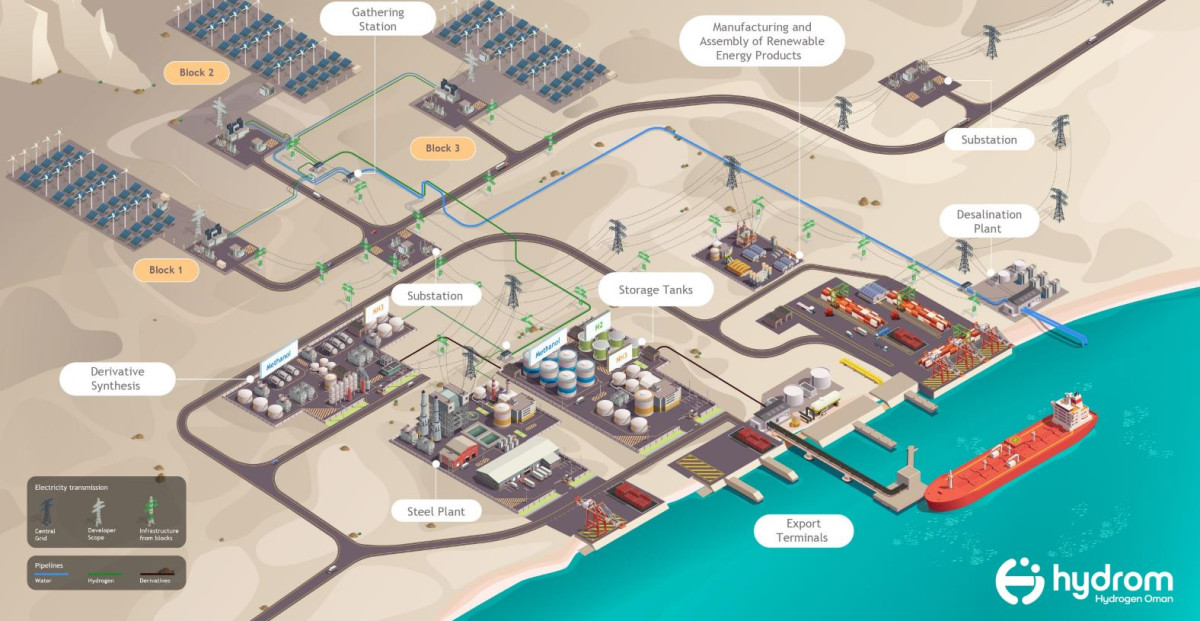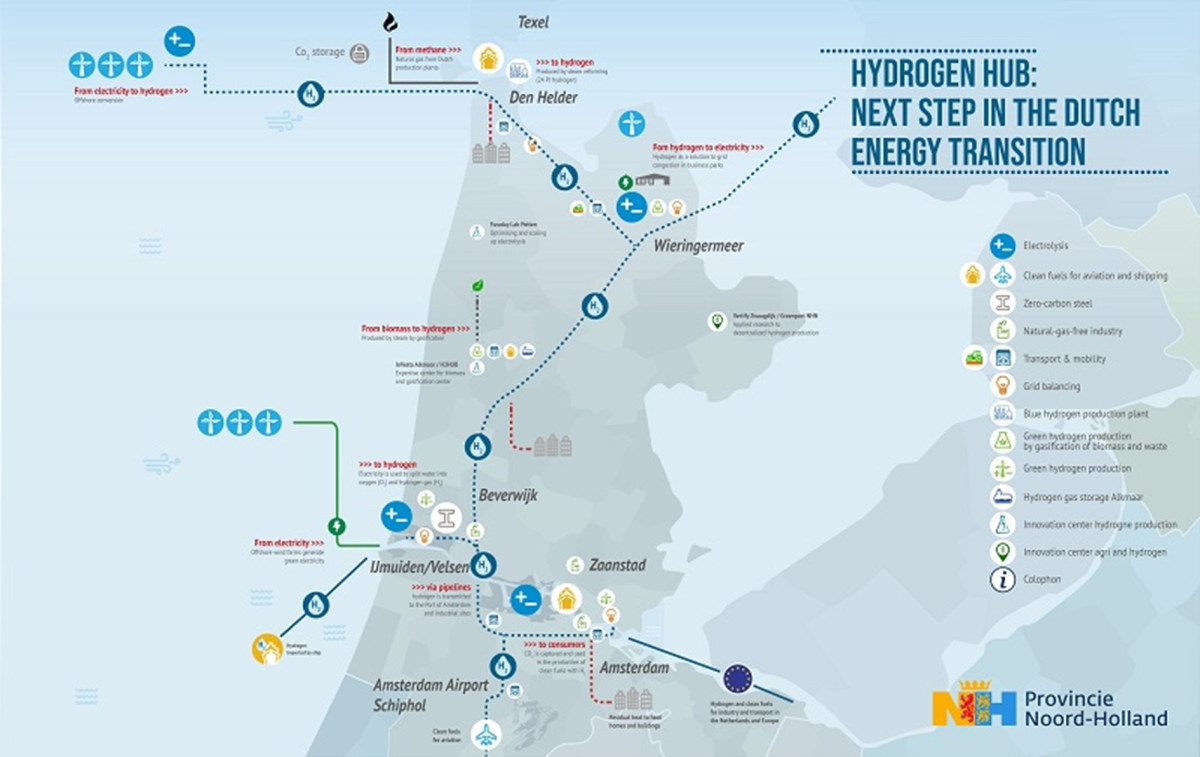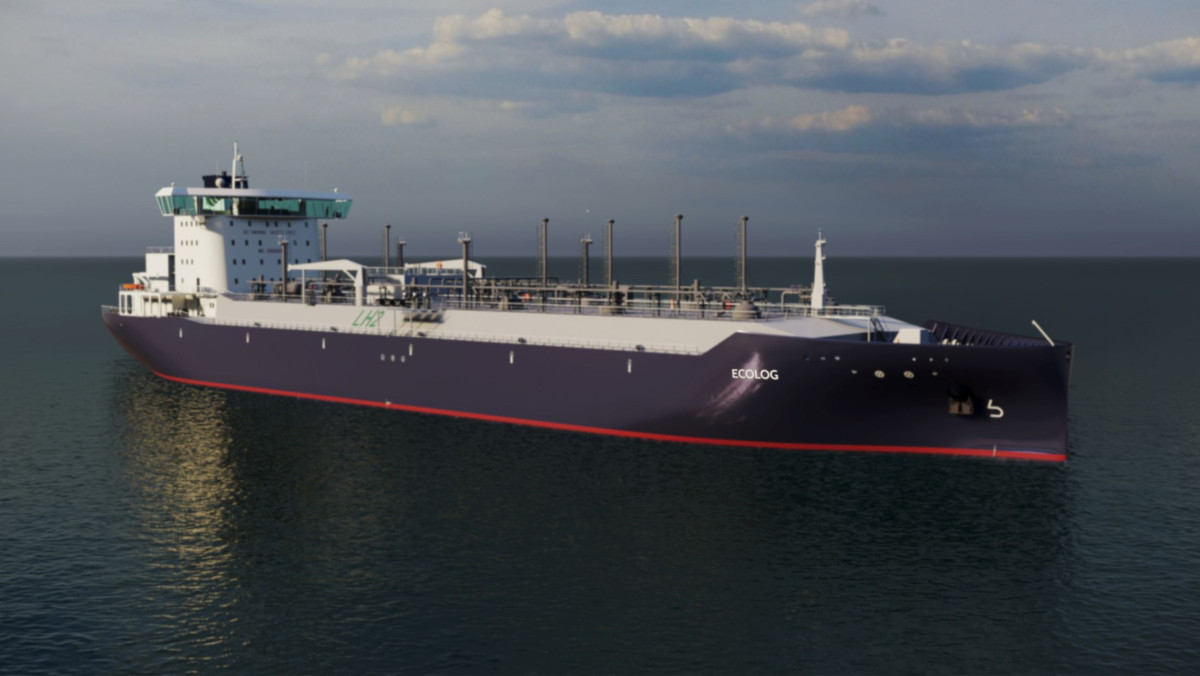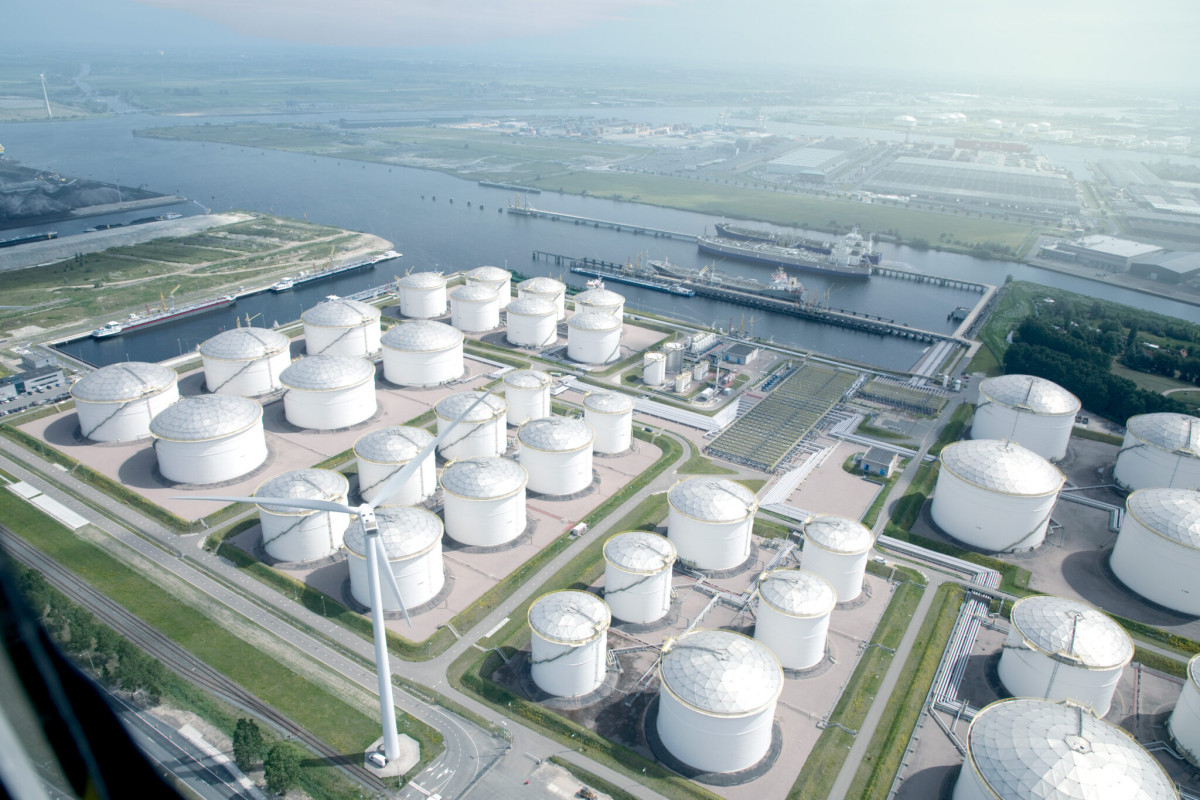Green hydrogen from Oman could power European industry - but at what cost?
Today, the Netherlands is one of Europe’s biggest liquefied natural gas (LNG) importers, taking in hundreds of shipments a year from the USA, Norway, Russia, and further afield. Yet if all goes to plan, then by the 2030s many of the tankers docking there could be carrying a cleaner fuel, one which has never before been shipped in significant quantities - liquid hydrogen made with renewable electricity.
Together with ten other parties, the port of Amsterdam is working to build the world’s first “liquid hydrogen corridor”, to transport the climate-neutral fuel all the way from renewable power plants in the deserts of Oman, via the port of Duqm, to the Netherlands and Germany, where industries plan to use it to make low-carbon chemicals and steel.
Land has already been set aside in Amsterdam for the Greek hydrogen logistics company EcoLog to build a terminal that could take in 200,000 tonnes of the clean fuel every year. The company has designed its own hydrogen tankers to dock there, and intends to have the facility up and running by 2029.
“We’re really trying to replicate what’s happened with LNG,” said Ellen Ruhotas, chief executive of EcoLog. “A bit like how now we import LNG from Qatar or Australia or Malaysia because they’re the cheapest places in the world, the same thing will happen with hydrogen.
“We’re focusing on connecting the places where hydrogen is cheapest, which is those countries where wind and solar energy come together. Really there are only four locations in the world where that happens - northern Africa, Australia, the south of Chile, and the Middle East around the Red Sea and Oman.”
Oman’s “hydrogen orchestrator” Hydrom has already granted development rights to five facilities that will use wind and solar energy to power electrolysers that separate water into hydrogen and oxygen. Ruhotas says that Oman will be able to make green hydrogen so cheaply that even once the cost of liquefying and transporting it has been factored in, it will still be cheaper than hydrogen generated in Europe. “Unsubsidised hydrogen made in Europe sits somewhere between 10 and 12 euros a kilo. We can deliver for half that price” she said.
Part of the business case for the hydrogen corridor is that it will work in synergy with EcoLog’s carbon-liquefaction project, also based in the port. When the hydrogen is turned back into a gas, the chill it releases will be used to liquefy carbon dioxide captured from Tata Steel’s Ijmuiden steelworks. The liquid CO2 will then be stored in empty gas fields in the North Sea.
EcoLog also intends to ship liquid hydrogen from Norway, Saudi-Arabia and Spain. These plans represent a step-change for a commodity that has so far only been shipped in small quantities on trial voyages. “We’re trying to create a supply chain that doesn’t exist,” said Ruhotas. “It’s really exciting.”
High hopes for hydrogen
EcoLog’s plans are just one part of Oman’s ambitions to become one of the world’s foremost exporters of green hydrogen. The Gulf state hopes that by supplying Europe’s demand for hydrogen, it can diversify its own economy away from declining fossil fuel exports. It has set aside 50,000km2 for the production of green hydrogen, an area larger than Slovakia, and is aiming to produce 7.5-8.5 million tonnes by 2050 - this would represent almost twice as much energy as it currently exports in the form of LNG.
The European Union, meanwhile, has done much to advertise itself as the world’s most eager customer of hydrogen, setting a target of importing 10 million tonnes by 2030. Germany alone expects to be importing 1.4-2.8 million tonnes by that year. Where exactly the continent expects to get all this hydrogen, and whether much of it will come by ship, is still uncertain. Plans have been laid for pipelines that would carry hydrogen to Germany as a gas from north Africa, the United Kingdom, Portugal and Spain, although a planned pipeline from Norway was scrapped last year due to lack of demand.
“We are not afraid that our supply chain will be superceded by pipelines” said Ruhotas, arguing they will not be able to deliver all the hydrogen the EU says it needs.
The German government expects that most of its hydrogen imports will come by ship until 2030. But it has said the business case for liquid hydrogen imports is “unclear”, and the import terminals it has permitted in Hamburg, Stade, Brunsbüttel are actually designed to take in ammonia - a chemical that can be broken down into hydrogen, or kept whole for use in fertilizer. Oman is also at work on several facilities that could produce millions of tonnes of ammonia.
An “implausible” business case
In the view of the Ariadne Project, a government-funded research alliance, it makes more sense for Germany to import hydrogen in the form of ammonia, so long as it is then used to make fertiliser rather than broken down into hydrogen.
One reason for this is that liquefaction is a highly energy-intensive process, and ammonia liquefies much closer to room temperature than hydrogen. Its boiling point is minus 33°C compared to minus 253°C for liquid hydrogen, or minus 162°C for LNG.
Ariadne’s researchers believe the business case for liquid hydrogen looks “increasingly implausible” due to the “high efficiency losses” involved in cooling it down to such low temperatures. Liquid hydrogen also has a low volumetric density, of not much more than a third of that of LNG, which means that many more ships are required to carry the same amount of energy.
While Ruhotas is confident that Oman’s low hydrogen production costs will offset the efficiency losses involved in liquefaction, others aren’t so sure. The financial intelligence firm S&P Global told Clean Energy Wire that it expects liquid hydrogen imports to be more expensive in 2030 than hydrogen produced within Europe. It estimates the former would cost $8-12/kg, the latter $6-10/kg.
It foresees the cheapest hydrogen coming to Europe via pipeline from north Africa, at $6-9/kg, although this pipeline is expected only to be able to carry 40 per cent of the EU’s targeted 10 million tonnes of hydrogen imports.
Matthew Hodgkinson, senior hydrogen analyst at S&P, told Clean Energy Wire that investors are less enthusiastic about liquid hydrogen than they were five years ago, and that hydrogen developers are increasingly looking to build electrolysers next to companies who want to buy it, rather than transporting it thousands of miles.
The clean energy thintank Agora Energiewende, meanwhile, also sees little role for liquid hydrogen imports in Germany’s future energy mix. The organisation’s hydrogen analyst Leandro Janke told Clean Energy Wire that “hydrogen imports for Germany are foreseen to happen either via pipeline or as derivatives [such as ammonia] for direct use in industry”, not via shipments of pure hydrogen.
Ominously for Ruhotas’s plan, previous attempts to ship liquid hydrogen on a large scale have come to nought. In 2022, the chairman of the green energy company Fortescue Future Industries, Andrew Forrest, claimed that “liquid hydrogen will become the largest seaborne trade in the world”, and signed a $50 billion memorandum of understanding with the energy company E.ON to ship 5 million tonnes of hydrogen per annum from Australia to Germany. But since then Fortescue has quietly shelved the plan.
“We’re going to buy the hydrogen”
Unlike Fortescue’s deal with E.ON, however, the plan for the Oman-Amsterdam corridor does have the backing of several offtakers. Tata Steel intends to use the hydrogen in its green steel plant in IJmuiden near Amsterdam. The chemicals company Gidara plans to use it in its Advanced Methanol Amsterdam Facility, and the German energy company ENBW has offered to be the project’s middleman in Germany, aggregating the demand of companies who want to buy the hydrogen. Some of the hydrogen would be sent to Duisburg, and piped into the 9,000 kilometres network the German government intends to build to distribute hydrogen around the country.
The eleven companies involved in the project hope to come to a final investment decision in the second quarter of next year. “If nothing unforeseen happens, we’re going to buy this hydrogen” Martin van der Velde, a spokesperson for Tata, told Clean Energy Wire. “The project can jump-start the entire hydrogen economy in the area”.
Despite these assurances, the clean energy investor and founder of Bloomberg New Energy Finance (BNEF) Michael Leibreich believes Ruhotas’s cost predictions are implausibly optimistic, and doubts it will ever deliver any hydrogen. "This project is just a fairy story, dressed up as a press release,” he told Clean Energy Wire. “There is more chance of making clean steel with unicorn dung than with liquid hydrogen imported from Oman."
“The Omanis clearly think they’re going to be making hydrogen for $2/kg. The world’s biggest hydrogen electrolyser project, NEOM in Saudi Arabia, was supposed to make hydrogen for $3/kg. My sources say there have been cost overruns and it’s going to be $4.50/kg.
“So you’ve got a cost-of-production problem, but if you’re importing it to Europe that’s the least of your problems. Once you’ve factored in the cost of liquefaction and shipping, there is no way that liquid hydrogen arriving in Amsterdam is going to cost less than $10/kg. European hydrogen can be made for €6 a kilo, and even that is too expensive to make green steel.”
In June Europe’s largest steelmaker ArcelorMittal cancelled two hydrogen-based green steel projects in Germany, having previously said that the production methods employed in these facilities would only be viable at a hydrogen price of around €2/kg.
Philip Verpoort, a hydrogen researcher at the Potsdam Institute for Climate Impact Research (PIK), is a little more optimistic about the prospects for liquid hydrogen. He told Clean Energy Wire that as hydrogen is expected to remain scarce for the next decade or so, it may be worth importing some by ship even if it is more expensive than getting it by pipeline.
That said, he also thinks it makes more sense for Germany to import products made with hydrogen, such as ammonia, or hot-briquetted iron for green steelmaking, rather than taking in shipments of the liquid itself. “This could avoid the cost of transporting hydrogen over long distances” he said.





